Auditing of Arena Reit: Risk Assessment and Audit Procedures
VerifiedAdded on 2023/06/07
|22
|4271
|66
Report
AI Summary
This report presents an audit of Arena Reit, a real estate company in Australia. It begins with an executive summary and introduction, followed by an analysis of key business risks, categorized into development, financial policy, operational, location, and appearance risks. The report then applies the audit risk model to assess inherent, control, and detection risks, determining a detection risk of 0.10. Analytical procedures are performed using financial ratios over three years, including net profit, operating, capital employed, asset turnover, current, and quick ratios, with commentary on each. The report details audit work steps using a substantive approach and includes a sampling plan. The conclusion summarizes the findings, highlighting Arena Reit's compliance with relevant guidelines and areas for improvement. Key business risks include operational, external, and regulatory factors, and the audit emphasizes the importance of understanding these risks for effective financial statement analysis. The report uses the International Accounting Standard (ISA) 315 guidelines to evaluate risk and includes calculations to determine detection risk. The report is a comprehensive audit of Arena Reit.
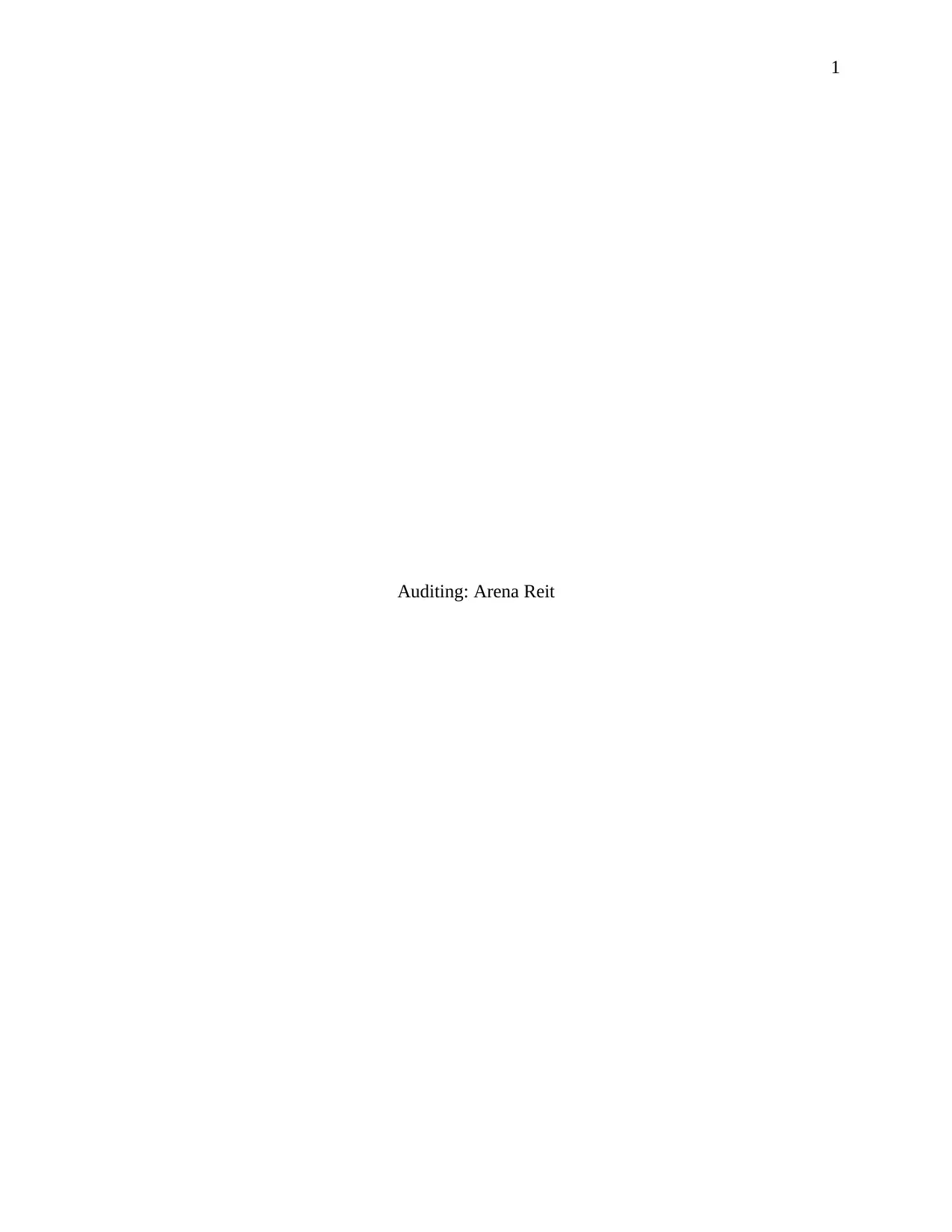
1
Auditing: Arena Reit
Auditing: Arena Reit
Paraphrase This Document
Need a fresh take? Get an instant paraphrase of this document with our AI Paraphraser
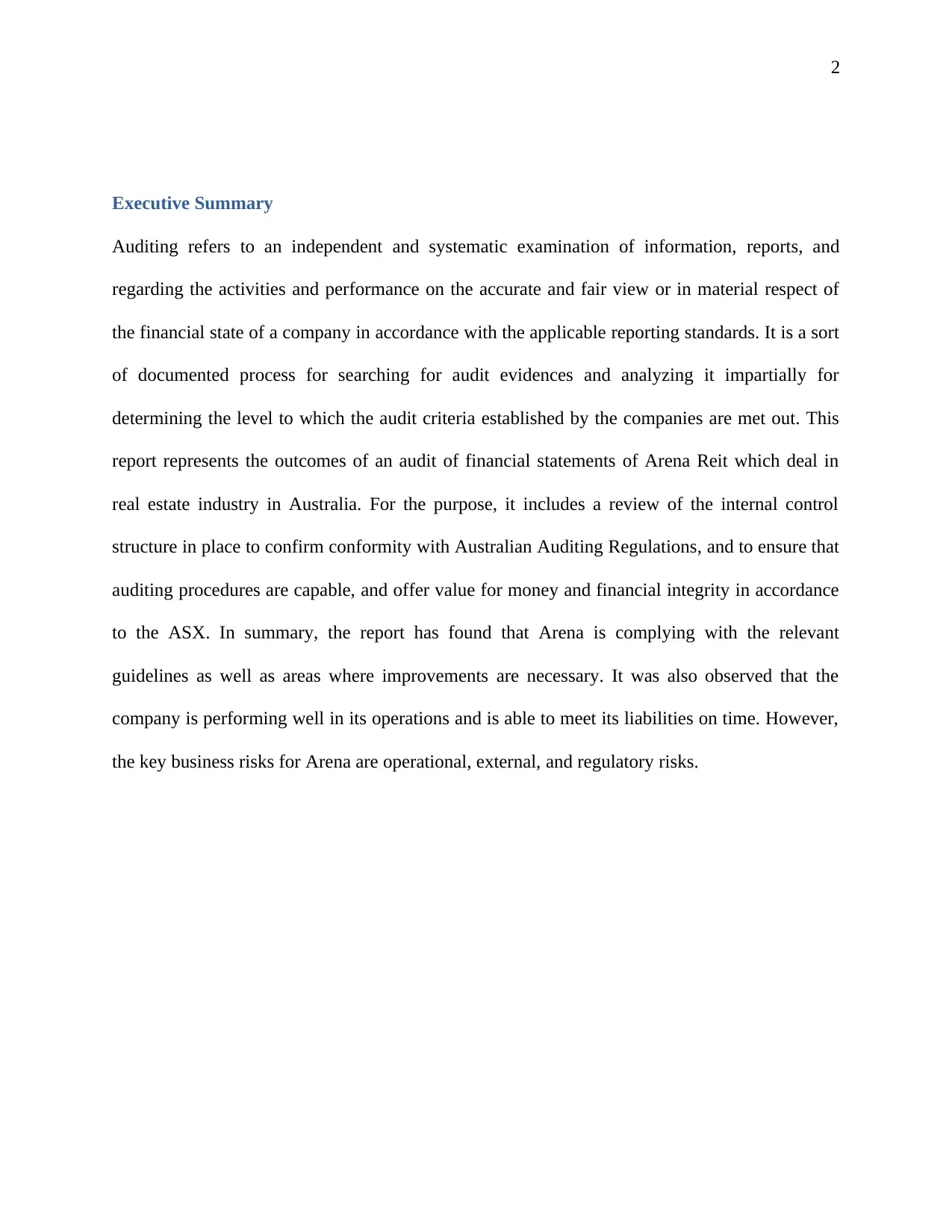
2
Executive Summary
Auditing refers to an independent and systematic examination of information, reports, and
regarding the activities and performance on the accurate and fair view or in material respect of
the financial state of a company in accordance with the applicable reporting standards. It is a sort
of documented process for searching for audit evidences and analyzing it impartially for
determining the level to which the audit criteria established by the companies are met out. This
report represents the outcomes of an audit of financial statements of Arena Reit which deal in
real estate industry in Australia. For the purpose, it includes a review of the internal control
structure in place to confirm conformity with Australian Auditing Regulations, and to ensure that
auditing procedures are capable, and offer value for money and financial integrity in accordance
to the ASX. In summary, the report has found that Arena is complying with the relevant
guidelines as well as areas where improvements are necessary. It was also observed that the
company is performing well in its operations and is able to meet its liabilities on time. However,
the key business risks for Arena are operational, external, and regulatory risks.
Executive Summary
Auditing refers to an independent and systematic examination of information, reports, and
regarding the activities and performance on the accurate and fair view or in material respect of
the financial state of a company in accordance with the applicable reporting standards. It is a sort
of documented process for searching for audit evidences and analyzing it impartially for
determining the level to which the audit criteria established by the companies are met out. This
report represents the outcomes of an audit of financial statements of Arena Reit which deal in
real estate industry in Australia. For the purpose, it includes a review of the internal control
structure in place to confirm conformity with Australian Auditing Regulations, and to ensure that
auditing procedures are capable, and offer value for money and financial integrity in accordance
to the ASX. In summary, the report has found that Arena is complying with the relevant
guidelines as well as areas where improvements are necessary. It was also observed that the
company is performing well in its operations and is able to meet its liabilities on time. However,
the key business risks for Arena are operational, external, and regulatory risks.
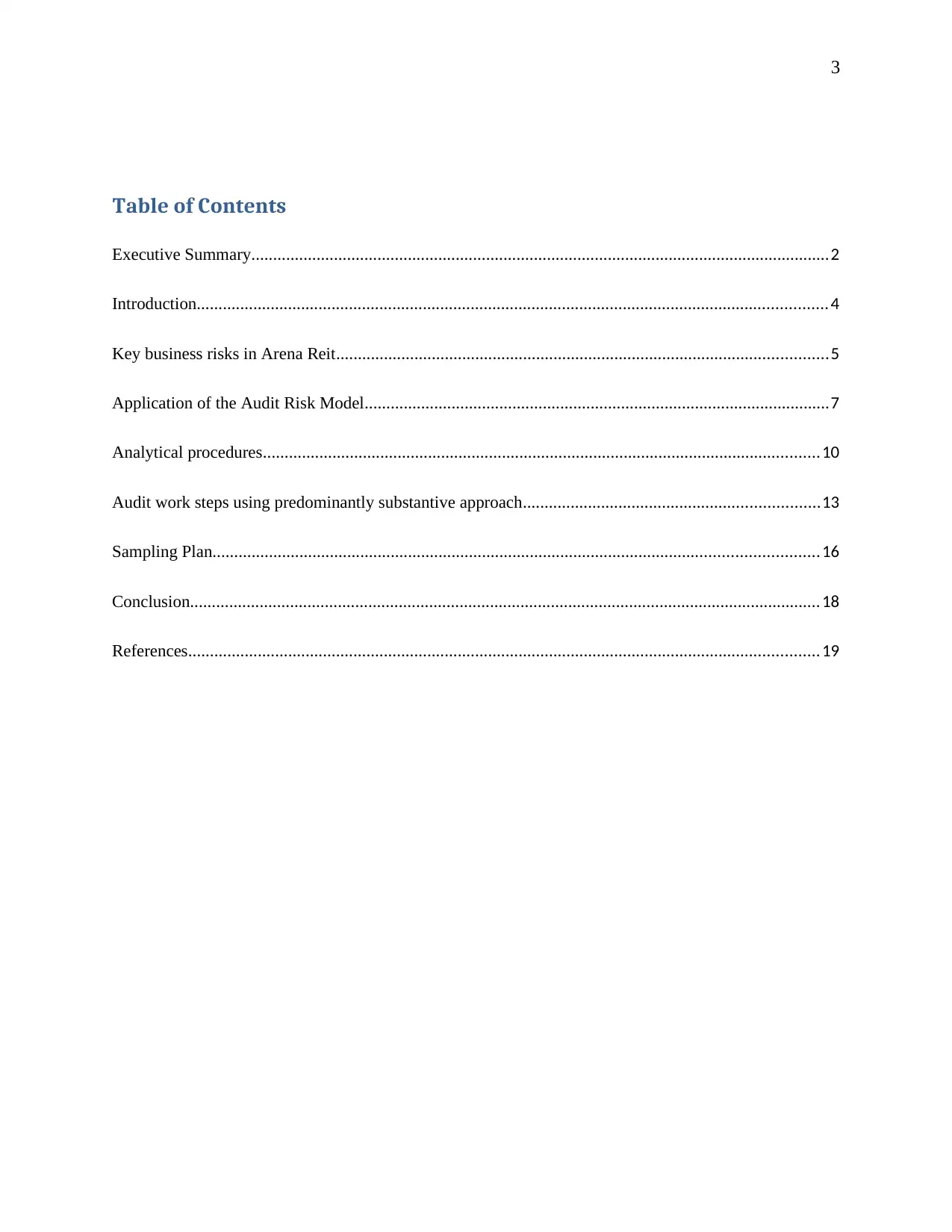
3
Table of Contents
Executive Summary.....................................................................................................................................2
Introduction.................................................................................................................................................4
Key business risks in Arena Reit.................................................................................................................5
Application of the Audit Risk Model...........................................................................................................7
Analytical procedures................................................................................................................................10
Audit work steps using predominantly substantive approach....................................................................13
Sampling Plan...........................................................................................................................................16
Conclusion.................................................................................................................................................18
References.................................................................................................................................................19
Table of Contents
Executive Summary.....................................................................................................................................2
Introduction.................................................................................................................................................4
Key business risks in Arena Reit.................................................................................................................5
Application of the Audit Risk Model...........................................................................................................7
Analytical procedures................................................................................................................................10
Audit work steps using predominantly substantive approach....................................................................13
Sampling Plan...........................................................................................................................................16
Conclusion.................................................................................................................................................18
References.................................................................................................................................................19
⊘ This is a preview!⊘
Do you want full access?
Subscribe today to unlock all pages.

Trusted by 1+ million students worldwide
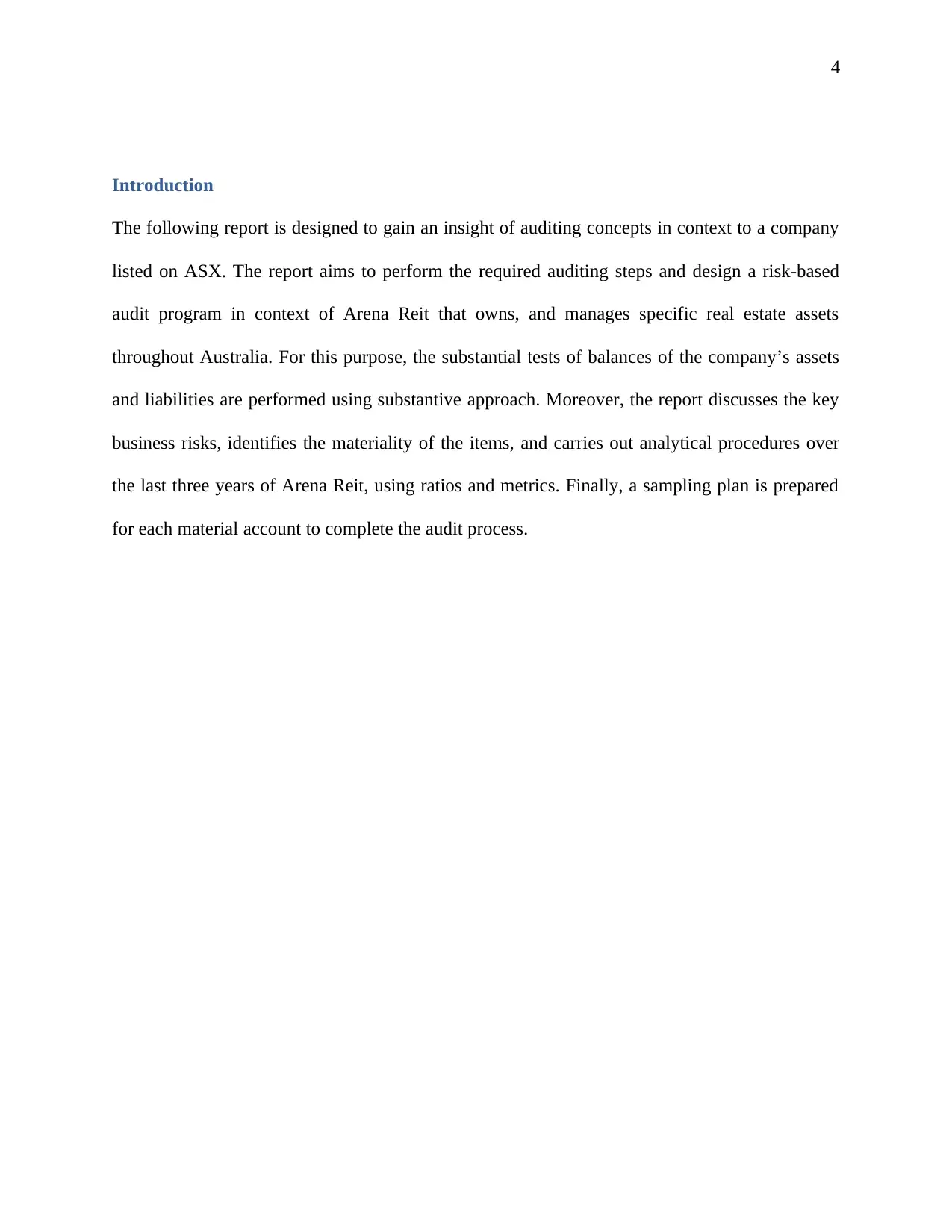
4
Introduction
The following report is designed to gain an insight of auditing concepts in context to a company
listed on ASX. The report aims to perform the required auditing steps and design a risk-based
audit program in context of Arena Reit that owns, and manages specific real estate assets
throughout Australia. For this purpose, the substantial tests of balances of the company’s assets
and liabilities are performed using substantive approach. Moreover, the report discusses the key
business risks, identifies the materiality of the items, and carries out analytical procedures over
the last three years of Arena Reit, using ratios and metrics. Finally, a sampling plan is prepared
for each material account to complete the audit process.
Introduction
The following report is designed to gain an insight of auditing concepts in context to a company
listed on ASX. The report aims to perform the required auditing steps and design a risk-based
audit program in context of Arena Reit that owns, and manages specific real estate assets
throughout Australia. For this purpose, the substantial tests of balances of the company’s assets
and liabilities are performed using substantive approach. Moreover, the report discusses the key
business risks, identifies the materiality of the items, and carries out analytical procedures over
the last three years of Arena Reit, using ratios and metrics. Finally, a sampling plan is prepared
for each material account to complete the audit process.
Paraphrase This Document
Need a fresh take? Get an instant paraphrase of this document with our AI Paraphraser
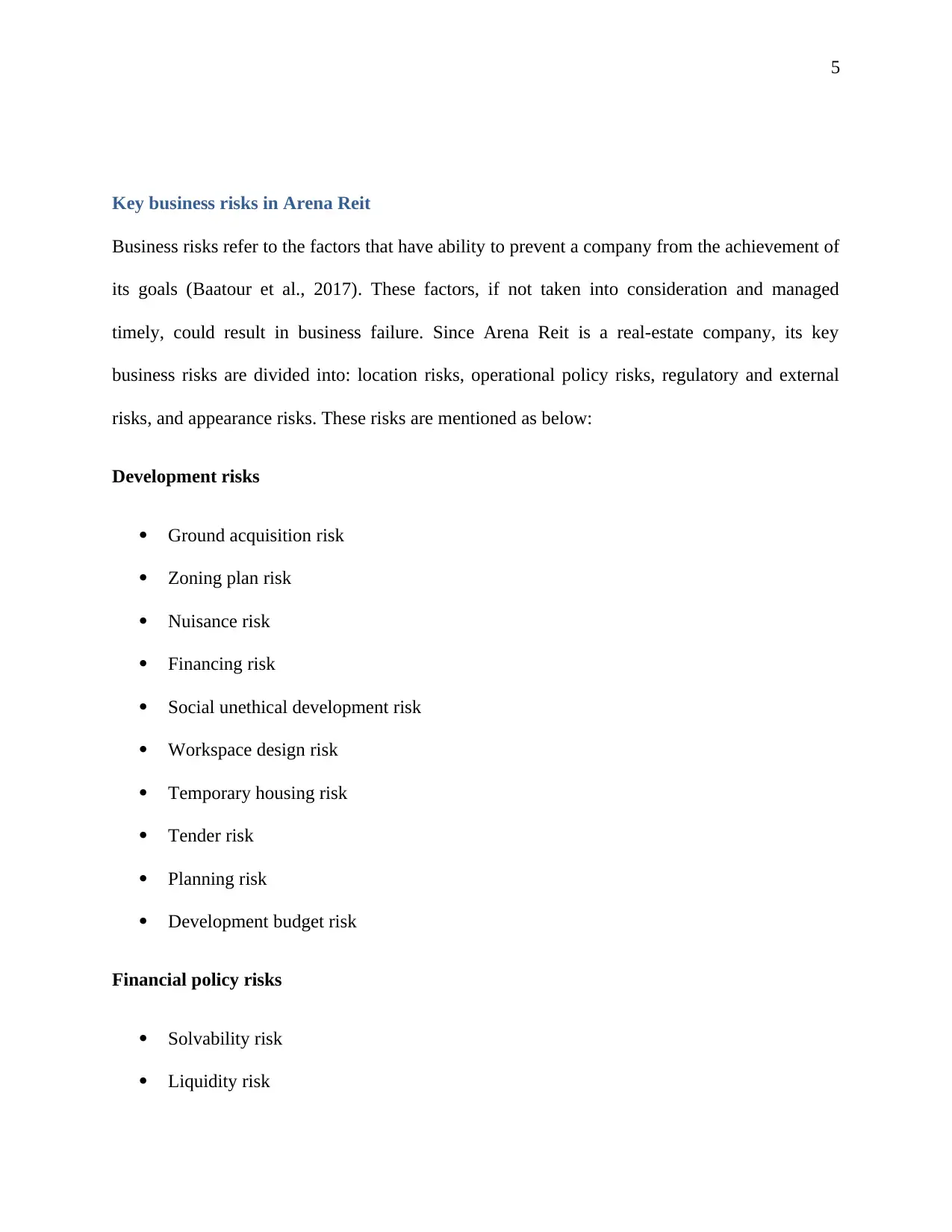
5
Key business risks in Arena Reit
Business risks refer to the factors that have ability to prevent a company from the achievement of
its goals (Baatour et al., 2017). These factors, if not taken into consideration and managed
timely, could result in business failure. Since Arena Reit is a real-estate company, its key
business risks are divided into: location risks, operational policy risks, regulatory and external
risks, and appearance risks. These risks are mentioned as below:
Development risks
Ground acquisition risk
Zoning plan risk
Nuisance risk
Financing risk
Social unethical development risk
Workspace design risk
Temporary housing risk
Tender risk
Planning risk
Development budget risk
Financial policy risks
Solvability risk
Liquidity risk
Key business risks in Arena Reit
Business risks refer to the factors that have ability to prevent a company from the achievement of
its goals (Baatour et al., 2017). These factors, if not taken into consideration and managed
timely, could result in business failure. Since Arena Reit is a real-estate company, its key
business risks are divided into: location risks, operational policy risks, regulatory and external
risks, and appearance risks. These risks are mentioned as below:
Development risks
Ground acquisition risk
Zoning plan risk
Nuisance risk
Financing risk
Social unethical development risk
Workspace design risk
Temporary housing risk
Tender risk
Planning risk
Development budget risk
Financial policy risks
Solvability risk
Liquidity risk
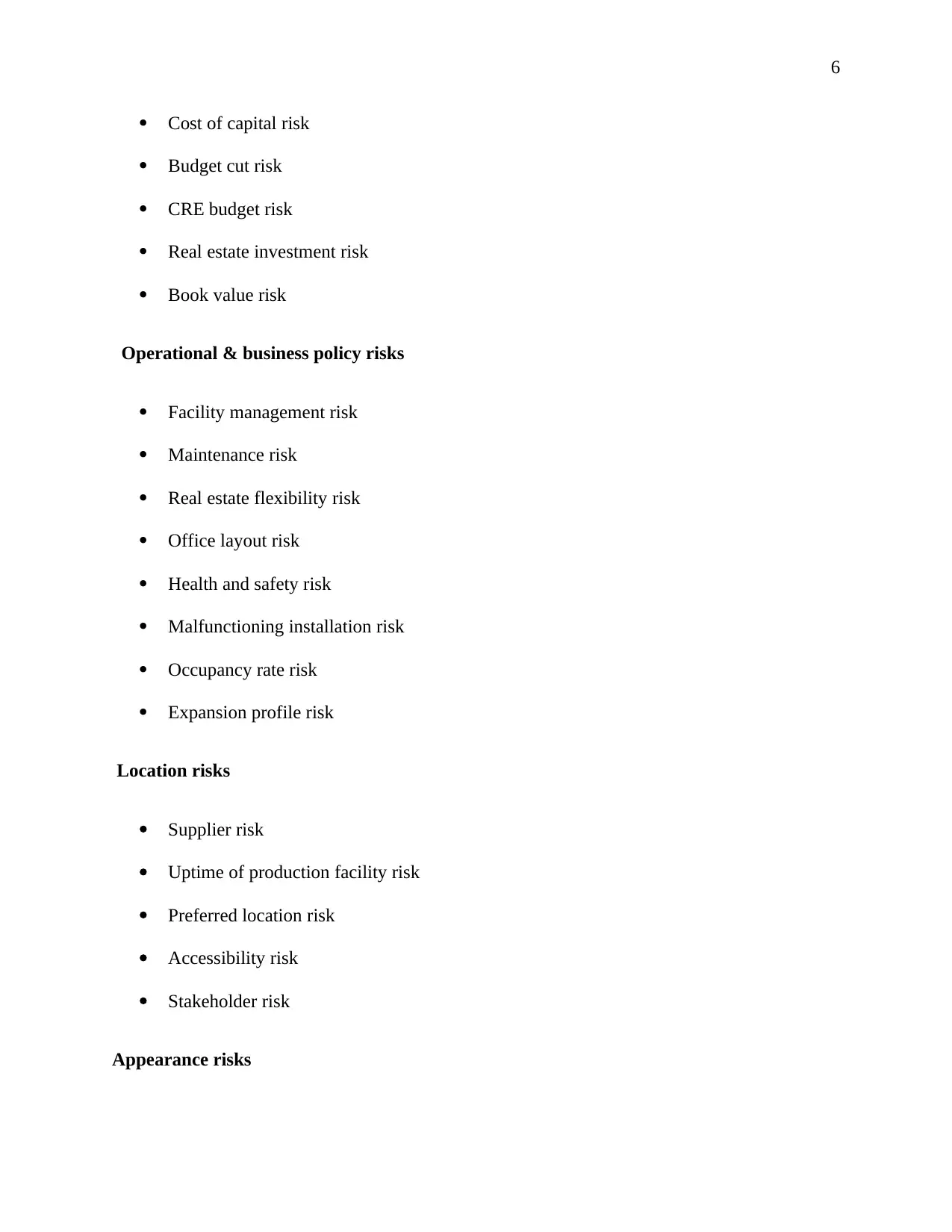
6
Cost of capital risk
Budget cut risk
CRE budget risk
Real estate investment risk
Book value risk
Operational & business policy risks
Facility management risk
Maintenance risk
Real estate flexibility risk
Office layout risk
Health and safety risk
Malfunctioning installation risk
Occupancy rate risk
Expansion profile risk
Location risks
Supplier risk
Uptime of production facility risk
Preferred location risk
Accessibility risk
Stakeholder risk
Appearance risks
Cost of capital risk
Budget cut risk
CRE budget risk
Real estate investment risk
Book value risk
Operational & business policy risks
Facility management risk
Maintenance risk
Real estate flexibility risk
Office layout risk
Health and safety risk
Malfunctioning installation risk
Occupancy rate risk
Expansion profile risk
Location risks
Supplier risk
Uptime of production facility risk
Preferred location risk
Accessibility risk
Stakeholder risk
Appearance risks
⊘ This is a preview!⊘
Do you want full access?
Subscribe today to unlock all pages.

Trusted by 1+ million students worldwide
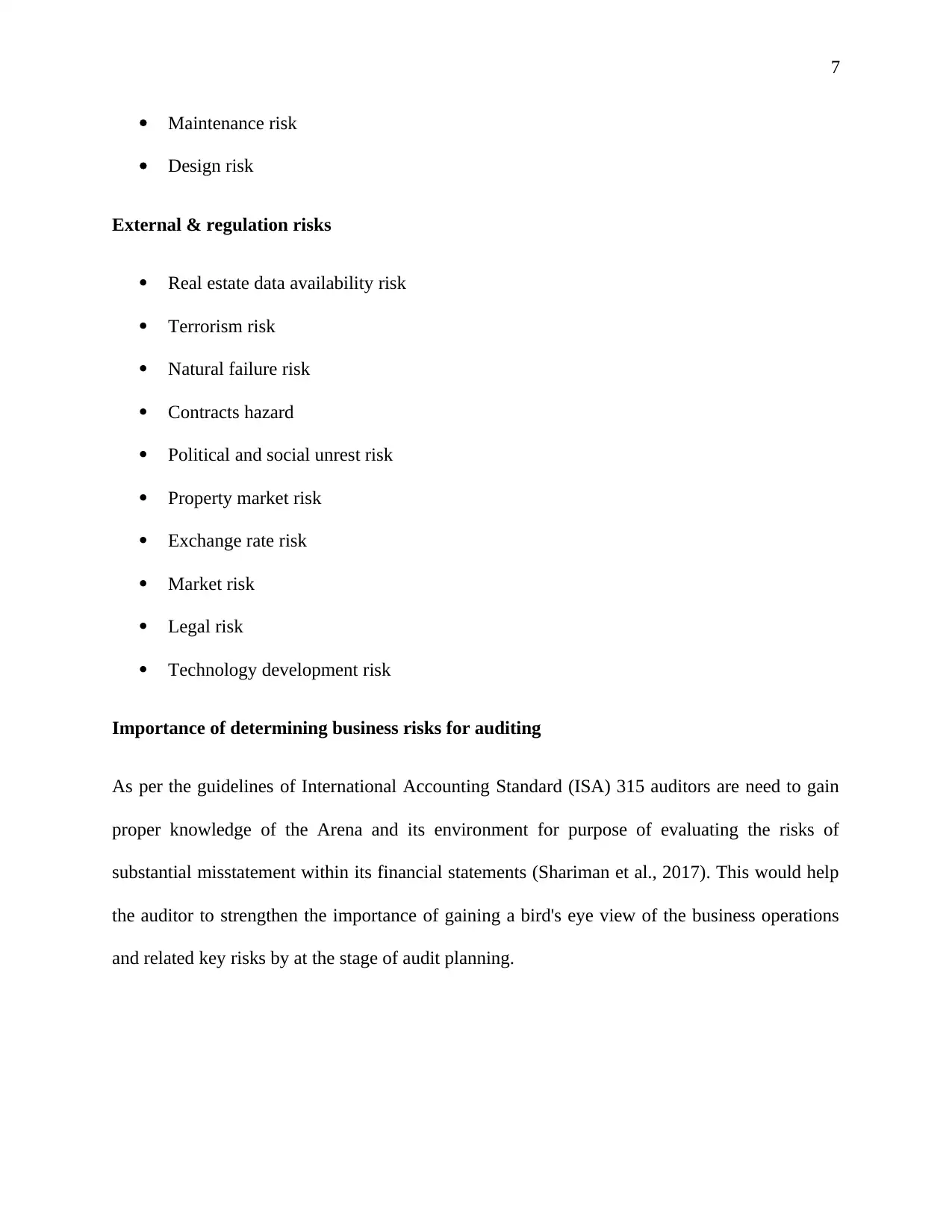
7
Maintenance risk
Design risk
External & regulation risks
Real estate data availability risk
Terrorism risk
Natural failure risk
Contracts hazard
Political and social unrest risk
Property market risk
Exchange rate risk
Market risk
Legal risk
Technology development risk
Importance of determining business risks for auditing
As per the guidelines of International Accounting Standard (ISA) 315 auditors are need to gain
proper knowledge of the Arena and its environment for purpose of evaluating the risks of
substantial misstatement within its financial statements (Shariman et al., 2017). This would help
the auditor to strengthen the importance of gaining a bird's eye view of the business operations
and related key risks by at the stage of audit planning.
Maintenance risk
Design risk
External & regulation risks
Real estate data availability risk
Terrorism risk
Natural failure risk
Contracts hazard
Political and social unrest risk
Property market risk
Exchange rate risk
Market risk
Legal risk
Technology development risk
Importance of determining business risks for auditing
As per the guidelines of International Accounting Standard (ISA) 315 auditors are need to gain
proper knowledge of the Arena and its environment for purpose of evaluating the risks of
substantial misstatement within its financial statements (Shariman et al., 2017). This would help
the auditor to strengthen the importance of gaining a bird's eye view of the business operations
and related key risks by at the stage of audit planning.
Paraphrase This Document
Need a fresh take? Get an instant paraphrase of this document with our AI Paraphraser
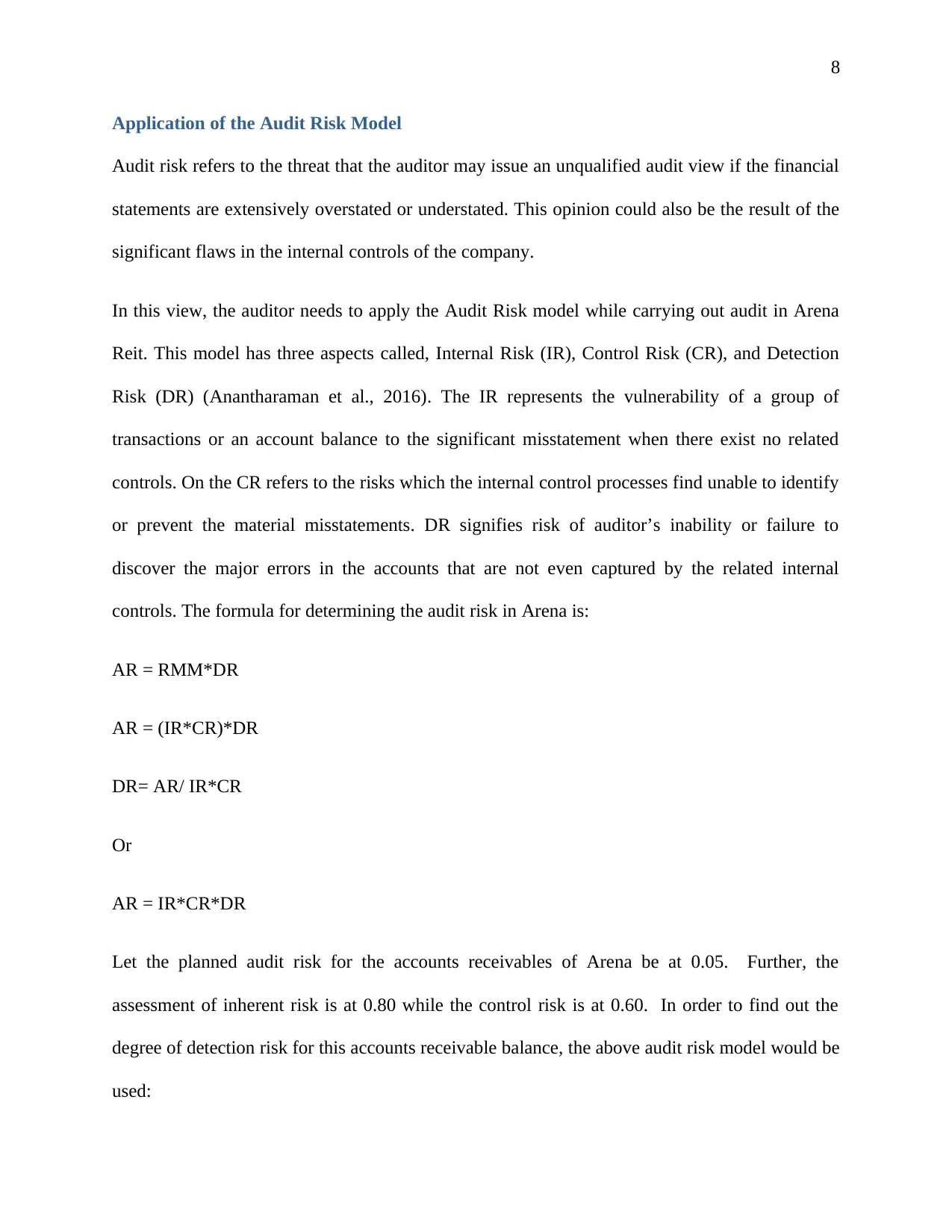
8
Application of the Audit Risk Model
Audit risk refers to the threat that the auditor may issue an unqualified audit view if the financial
statements are extensively overstated or understated. This opinion could also be the result of the
significant flaws in the internal controls of the company.
In this view, the auditor needs to apply the Audit Risk model while carrying out audit in Arena
Reit. This model has three aspects called, Internal Risk (IR), Control Risk (CR), and Detection
Risk (DR) (Anantharaman et al., 2016). The IR represents the vulnerability of a group of
transactions or an account balance to the significant misstatement when there exist no related
controls. On the CR refers to the risks which the internal control processes find unable to identify
or prevent the material misstatements. DR signifies risk of auditor’s inability or failure to
discover the major errors in the accounts that are not even captured by the related internal
controls. The formula for determining the audit risk in Arena is:
AR = RMM*DR
AR = (IR*CR)*DR
DR= AR/ IR*CR
Or
AR = IR*CR*DR
Let the planned audit risk for the accounts receivables of Arena be at 0.05. Further, the
assessment of inherent risk is at 0.80 while the control risk is at 0.60. In order to find out the
degree of detection risk for this accounts receivable balance, the above audit risk model would be
used:
Application of the Audit Risk Model
Audit risk refers to the threat that the auditor may issue an unqualified audit view if the financial
statements are extensively overstated or understated. This opinion could also be the result of the
significant flaws in the internal controls of the company.
In this view, the auditor needs to apply the Audit Risk model while carrying out audit in Arena
Reit. This model has three aspects called, Internal Risk (IR), Control Risk (CR), and Detection
Risk (DR) (Anantharaman et al., 2016). The IR represents the vulnerability of a group of
transactions or an account balance to the significant misstatement when there exist no related
controls. On the CR refers to the risks which the internal control processes find unable to identify
or prevent the material misstatements. DR signifies risk of auditor’s inability or failure to
discover the major errors in the accounts that are not even captured by the related internal
controls. The formula for determining the audit risk in Arena is:
AR = RMM*DR
AR = (IR*CR)*DR
DR= AR/ IR*CR
Or
AR = IR*CR*DR
Let the planned audit risk for the accounts receivables of Arena be at 0.05. Further, the
assessment of inherent risk is at 0.80 while the control risk is at 0.60. In order to find out the
degree of detection risk for this accounts receivable balance, the above audit risk model would be
used:
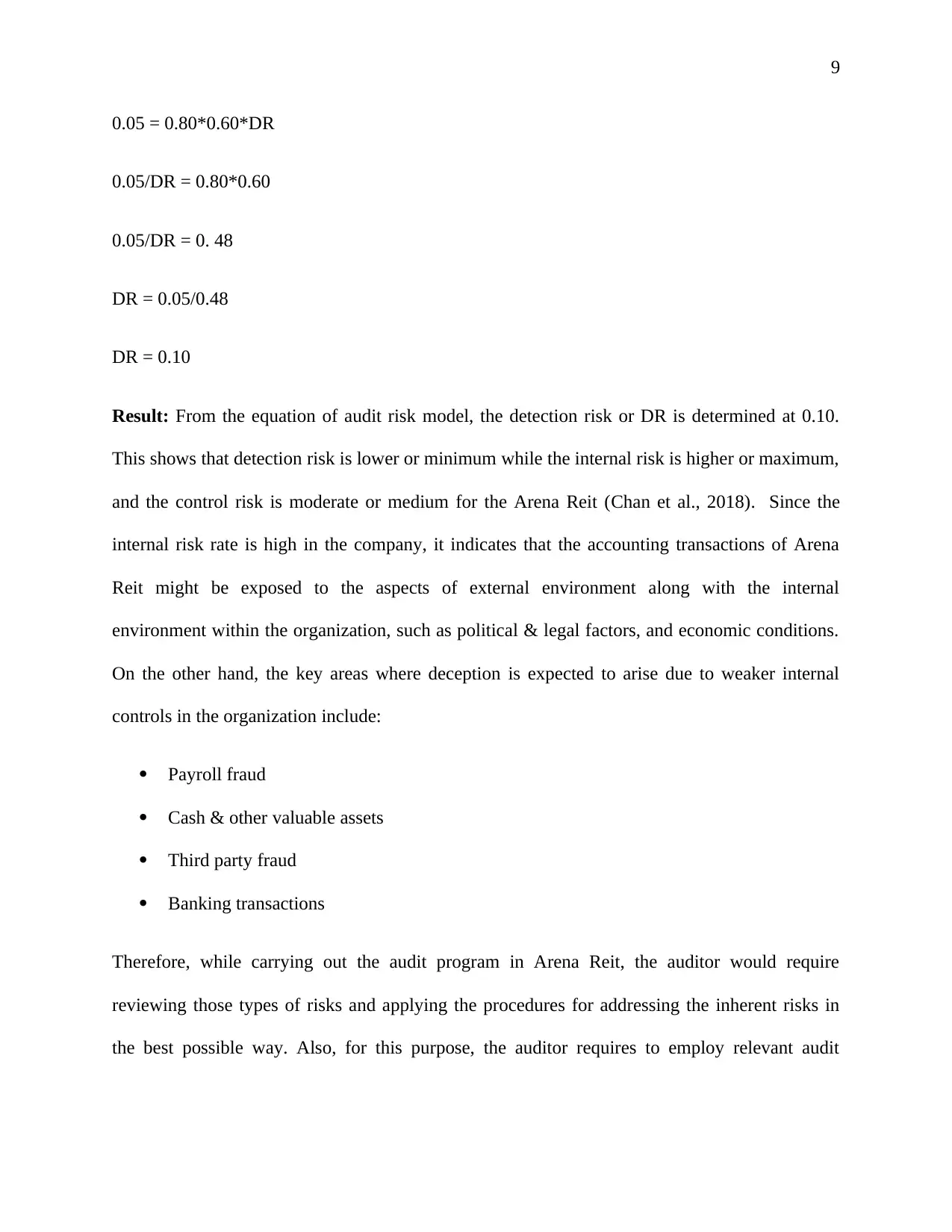
9
0.05 = 0.80*0.60*DR
0.05/DR = 0.80*0.60
0.05/DR = 0. 48
DR = 0.05/0.48
DR = 0.10
Result: From the equation of audit risk model, the detection risk or DR is determined at 0.10.
This shows that detection risk is lower or minimum while the internal risk is higher or maximum,
and the control risk is moderate or medium for the Arena Reit (Chan et al., 2018). Since the
internal risk rate is high in the company, it indicates that the accounting transactions of Arena
Reit might be exposed to the aspects of external environment along with the internal
environment within the organization, such as political & legal factors, and economic conditions.
On the other hand, the key areas where deception is expected to arise due to weaker internal
controls in the organization include:
Payroll fraud
Cash & other valuable assets
Third party fraud
Banking transactions
Therefore, while carrying out the audit program in Arena Reit, the auditor would require
reviewing those types of risks and applying the procedures for addressing the inherent risks in
the best possible way. Also, for this purpose, the auditor requires to employ relevant audit
0.05 = 0.80*0.60*DR
0.05/DR = 0.80*0.60
0.05/DR = 0. 48
DR = 0.05/0.48
DR = 0.10
Result: From the equation of audit risk model, the detection risk or DR is determined at 0.10.
This shows that detection risk is lower or minimum while the internal risk is higher or maximum,
and the control risk is moderate or medium for the Arena Reit (Chan et al., 2018). Since the
internal risk rate is high in the company, it indicates that the accounting transactions of Arena
Reit might be exposed to the aspects of external environment along with the internal
environment within the organization, such as political & legal factors, and economic conditions.
On the other hand, the key areas where deception is expected to arise due to weaker internal
controls in the organization include:
Payroll fraud
Cash & other valuable assets
Third party fraud
Banking transactions
Therefore, while carrying out the audit program in Arena Reit, the auditor would require
reviewing those types of risks and applying the procedures for addressing the inherent risks in
the best possible way. Also, for this purpose, the auditor requires to employ relevant audit
⊘ This is a preview!⊘
Do you want full access?
Subscribe today to unlock all pages.

Trusted by 1+ million students worldwide
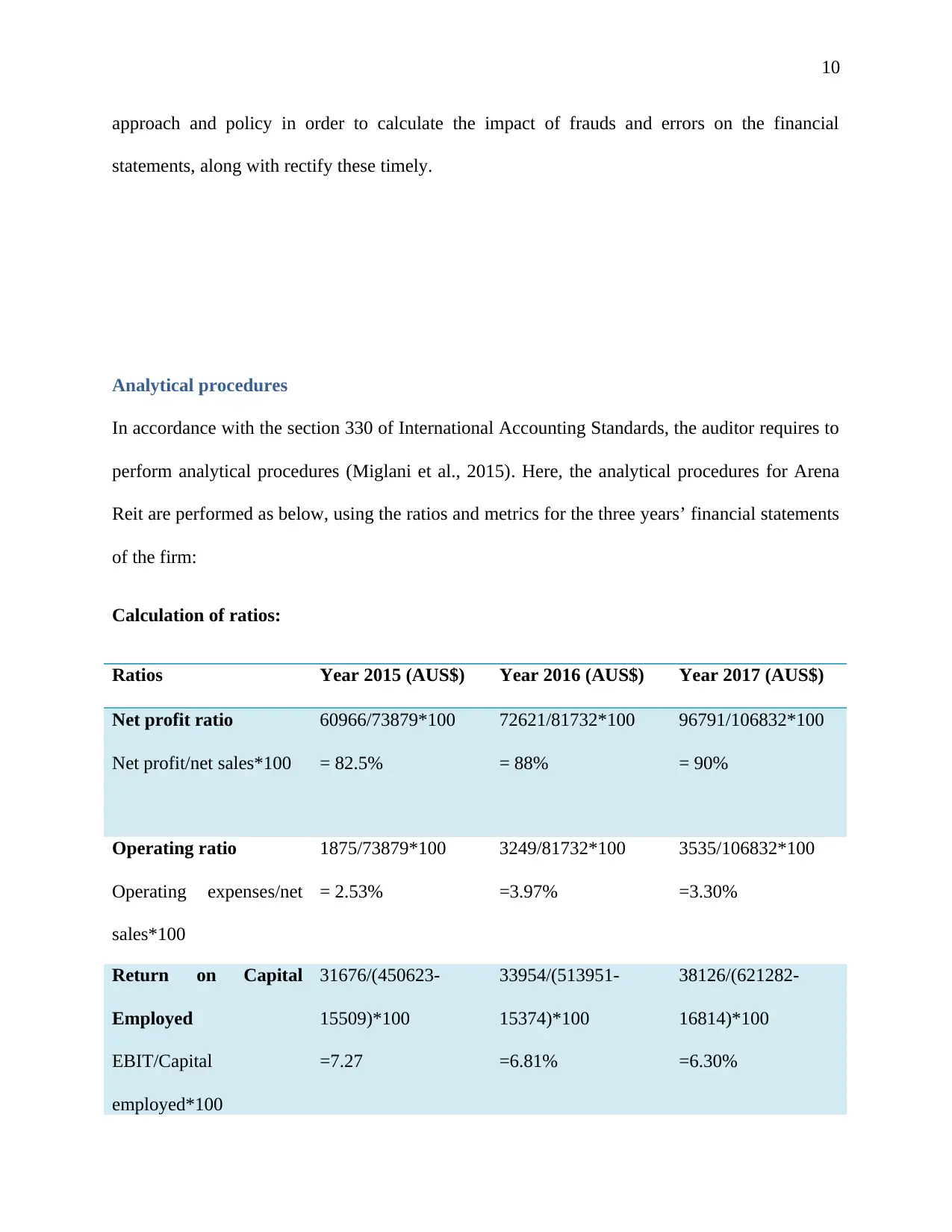
10
approach and policy in order to calculate the impact of frauds and errors on the financial
statements, along with rectify these timely.
Analytical procedures
In accordance with the section 330 of International Accounting Standards, the auditor requires to
perform analytical procedures (Miglani et al., 2015). Here, the analytical procedures for Arena
Reit are performed as below, using the ratios and metrics for the three years’ financial statements
of the firm:
Calculation of ratios:
Ratios Year 2015 (AUS$) Year 2016 (AUS$) Year 2017 (AUS$)
Net profit ratio
Net profit/net sales*100
60966/73879*100
= 82.5%
72621/81732*100
= 88%
96791/106832*100
= 90%
Operating ratio
Operating expenses/net
sales*100
1875/73879*100
= 2.53%
3249/81732*100
=3.97%
3535/106832*100
=3.30%
Return on Capital
Employed
EBIT/Capital
employed*100
31676/(450623-
15509)*100
=7.27
33954/(513951-
15374)*100
=6.81%
38126/(621282-
16814)*100
=6.30%
approach and policy in order to calculate the impact of frauds and errors on the financial
statements, along with rectify these timely.
Analytical procedures
In accordance with the section 330 of International Accounting Standards, the auditor requires to
perform analytical procedures (Miglani et al., 2015). Here, the analytical procedures for Arena
Reit are performed as below, using the ratios and metrics for the three years’ financial statements
of the firm:
Calculation of ratios:
Ratios Year 2015 (AUS$) Year 2016 (AUS$) Year 2017 (AUS$)
Net profit ratio
Net profit/net sales*100
60966/73879*100
= 82.5%
72621/81732*100
= 88%
96791/106832*100
= 90%
Operating ratio
Operating expenses/net
sales*100
1875/73879*100
= 2.53%
3249/81732*100
=3.97%
3535/106832*100
=3.30%
Return on Capital
Employed
EBIT/Capital
employed*100
31676/(450623-
15509)*100
=7.27
33954/(513951-
15374)*100
=6.81%
38126/(621282-
16814)*100
=6.30%
Paraphrase This Document
Need a fresh take? Get an instant paraphrase of this document with our AI Paraphraser
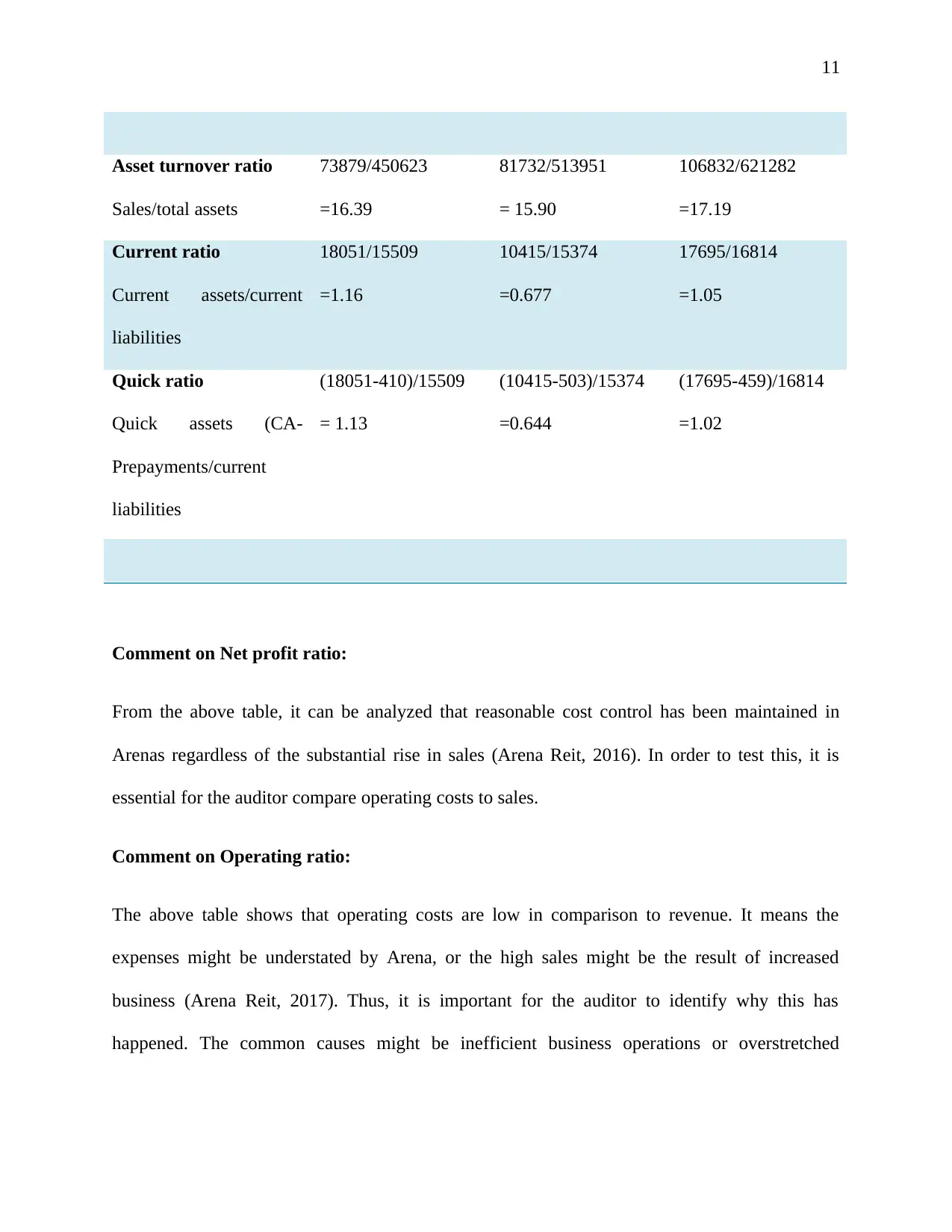
11
Asset turnover ratio
Sales/total assets
73879/450623
=16.39
81732/513951
= 15.90
106832/621282
=17.19
Current ratio
Current assets/current
liabilities
18051/15509
=1.16
10415/15374
=0.677
17695/16814
=1.05
Quick ratio
Quick assets (CA-
Prepayments/current
liabilities
(18051-410)/15509
= 1.13
(10415-503)/15374
=0.644
(17695-459)/16814
=1.02
Comment on Net profit ratio:
From the above table, it can be analyzed that reasonable cost control has been maintained in
Arenas regardless of the substantial rise in sales (Arena Reit, 2016). In order to test this, it is
essential for the auditor compare operating costs to sales.
Comment on Operating ratio:
The above table shows that operating costs are low in comparison to revenue. It means the
expenses might be understated by Arena, or the high sales might be the result of increased
business (Arena Reit, 2017). Thus, it is important for the auditor to identify why this has
happened. The common causes might be inefficient business operations or overstretched
Asset turnover ratio
Sales/total assets
73879/450623
=16.39
81732/513951
= 15.90
106832/621282
=17.19
Current ratio
Current assets/current
liabilities
18051/15509
=1.16
10415/15374
=0.677
17695/16814
=1.05
Quick ratio
Quick assets (CA-
Prepayments/current
liabilities
(18051-410)/15509
= 1.13
(10415-503)/15374
=0.644
(17695-459)/16814
=1.02
Comment on Net profit ratio:
From the above table, it can be analyzed that reasonable cost control has been maintained in
Arenas regardless of the substantial rise in sales (Arena Reit, 2016). In order to test this, it is
essential for the auditor compare operating costs to sales.
Comment on Operating ratio:
The above table shows that operating costs are low in comparison to revenue. It means the
expenses might be understated by Arena, or the high sales might be the result of increased
business (Arena Reit, 2017). Thus, it is important for the auditor to identify why this has
happened. The common causes might be inefficient business operations or overstretched
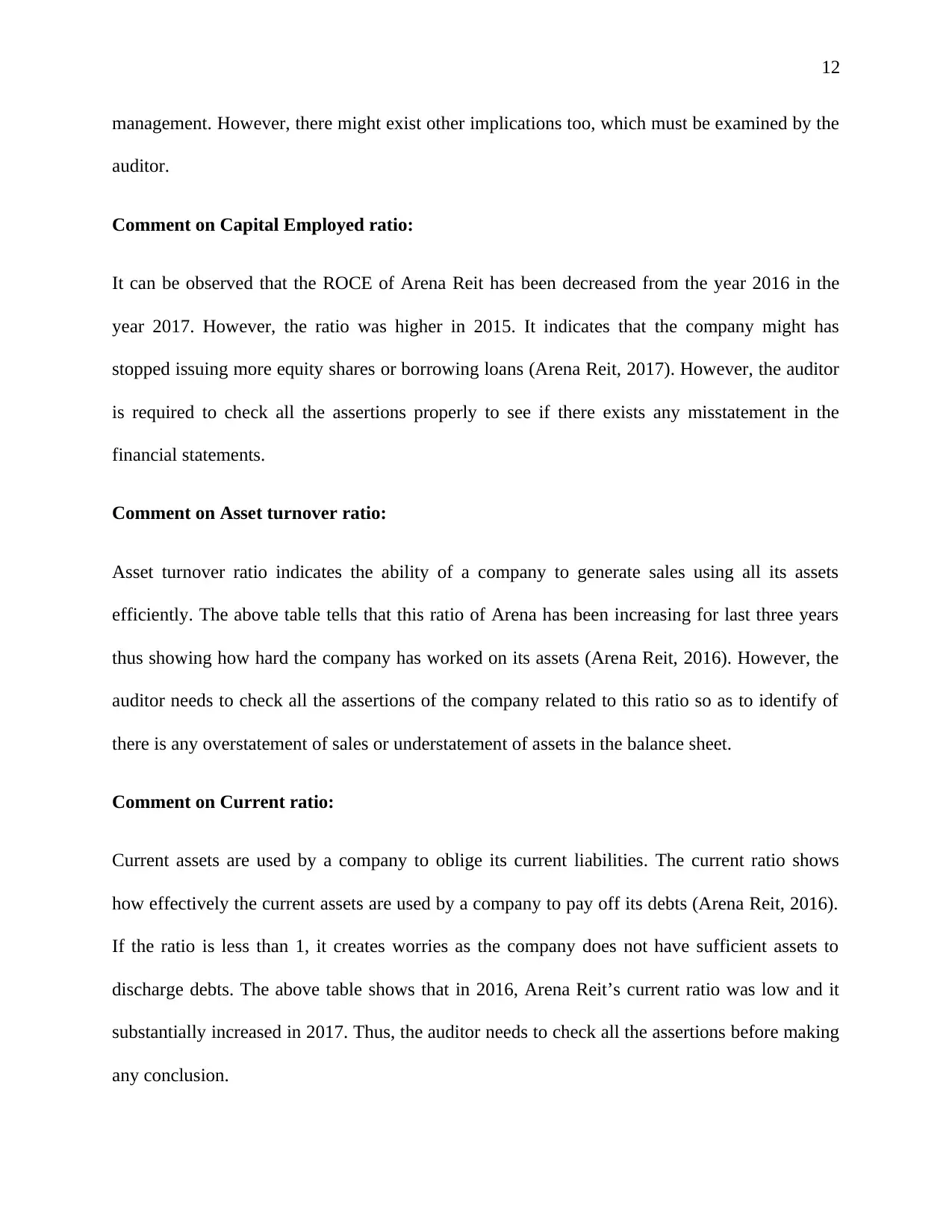
12
management. However, there might exist other implications too, which must be examined by the
auditor.
Comment on Capital Employed ratio:
It can be observed that the ROCE of Arena Reit has been decreased from the year 2016 in the
year 2017. However, the ratio was higher in 2015. It indicates that the company might has
stopped issuing more equity shares or borrowing loans (Arena Reit, 2017). However, the auditor
is required to check all the assertions properly to see if there exists any misstatement in the
financial statements.
Comment on Asset turnover ratio:
Asset turnover ratio indicates the ability of a company to generate sales using all its assets
efficiently. The above table tells that this ratio of Arena has been increasing for last three years
thus showing how hard the company has worked on its assets (Arena Reit, 2016). However, the
auditor needs to check all the assertions of the company related to this ratio so as to identify of
there is any overstatement of sales or understatement of assets in the balance sheet.
Comment on Current ratio:
Current assets are used by a company to oblige its current liabilities. The current ratio shows
how effectively the current assets are used by a company to pay off its debts (Arena Reit, 2016).
If the ratio is less than 1, it creates worries as the company does not have sufficient assets to
discharge debts. The above table shows that in 2016, Arena Reit’s current ratio was low and it
substantially increased in 2017. Thus, the auditor needs to check all the assertions before making
any conclusion.
management. However, there might exist other implications too, which must be examined by the
auditor.
Comment on Capital Employed ratio:
It can be observed that the ROCE of Arena Reit has been decreased from the year 2016 in the
year 2017. However, the ratio was higher in 2015. It indicates that the company might has
stopped issuing more equity shares or borrowing loans (Arena Reit, 2017). However, the auditor
is required to check all the assertions properly to see if there exists any misstatement in the
financial statements.
Comment on Asset turnover ratio:
Asset turnover ratio indicates the ability of a company to generate sales using all its assets
efficiently. The above table tells that this ratio of Arena has been increasing for last three years
thus showing how hard the company has worked on its assets (Arena Reit, 2016). However, the
auditor needs to check all the assertions of the company related to this ratio so as to identify of
there is any overstatement of sales or understatement of assets in the balance sheet.
Comment on Current ratio:
Current assets are used by a company to oblige its current liabilities. The current ratio shows
how effectively the current assets are used by a company to pay off its debts (Arena Reit, 2016).
If the ratio is less than 1, it creates worries as the company does not have sufficient assets to
discharge debts. The above table shows that in 2016, Arena Reit’s current ratio was low and it
substantially increased in 2017. Thus, the auditor needs to check all the assertions before making
any conclusion.
⊘ This is a preview!⊘
Do you want full access?
Subscribe today to unlock all pages.

Trusted by 1+ million students worldwide
1 out of 22
Related Documents
Your All-in-One AI-Powered Toolkit for Academic Success.
+13062052269
info@desklib.com
Available 24*7 on WhatsApp / Email
![[object Object]](/_next/static/media/star-bottom.7253800d.svg)
Unlock your academic potential
Copyright © 2020–2025 A2Z Services. All Rights Reserved. Developed and managed by ZUCOL.





